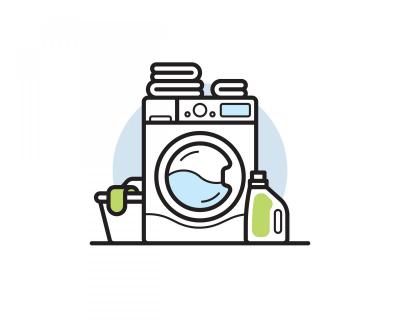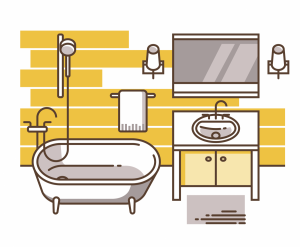Ways to Conserve Water Indoors
Small adjustments can have a big impact and they all start with you.
| Drips Per Minute | Water Wasted Per Day (Gallons) | Water Wasted Per Month (Gallons) | Water Wasted Per Year (Gallons) |
|---|---|---|---|
| 5 | .75 | 22 | 263 |
| 10 | 1.5 | 43 | 526 |
| 20 | 2.9 | 86 | 1,051 |
| 30 | 4.3 | 130 | 1,577 |
| 40 | 5.8 | 173 | 2,103 |
| 50 | 7.2 | 216 | 2,628 |
| 60 | 8.6 | 259 | 3,154 |
| 70 | 10.1 | 302 | 3,679 |
| 80 | 11.5 | 346 | 4,205 |
| 90 | 13 | 389 | 4,731 |
| 100 | 14.4 | 432 | 5,256 |
Listed below are some indoor water conservation ideas that are simple and easy to follow. Let's all do our part and practice year-round, wise water use to maximize our existing water resources and the existing infrastructure used to provide a safe and reliable water supply.
For Every Room in the House With Plumbing
- Repair leaky faucets, indoors, and out.
- Consider replacing old equipment (like toilets, dishwashers and laundry machines).
In the Kitchen
- When washing dishes by hand, don’t let the water run. Fill one basin with wash water and the other with rinse water.
- Dishwashers typically use less water than washing dishes by hand. Now, Energy Star dishwashers save even more water and energy.
- If your dishwasher is new, cut back on rinsing. Newer models clean more thoroughly than older ones.
- Designate one glass for your drinking water each day, or refill a water bottle. This will cut down on the number of glasses to wash.
- Soak pots and pans instead of letting the water run while you scrape them clean.
- Use the garbage disposal sparingly. Instead, compost vegetable food waste and save gallons every time.
- Wash your fruits and vegetables in a pan of water instead of running water from the tap.
- Don’t use running water to thaw food. For water efficiency and food safety, defrost food in the refrigerator.
- Install an instant water heater near your kitchen sink so you don’t have to run the water while it heats up. This also reduces energy costs.
- Keep a pitcher of drinking water in the refrigerator instead of running the tap. This way, every drop goes down you and not the drain.
- Reuse leftover water from cooked or steamed foods to start a nutritious soup, it’s one more way to get eight glasses of water a day.
- Cook food in as little water as possible. This also helps it retain more nutrients.
- Select the proper pan size for cooking. Large pans may require more cooking water than necessary.
- If you accidentally drop ice cubes, don’t throw them in the sink. Drop them in a house plant instead.
- Collect the water you use while rinsing fruit and vegetables. Use it to water house plants.
- When shopping for a new dishwasher, use the Consortium for Energy Efficiency website to compare water use between models.
 In the Laundry Room
In the Laundry Room
- When doing laundry, match the water level to the size of the load.
- Washing dark clothes in cold water saves water and energy, and helps your clothes retain their color.
- When shopping for a new washing machine, compare resource savings among Energy Star models. Some can save up to 20 gallons of water per load.
- Have a plumber re-route your greywater to trees and plants rather than the sewer line. Check with your city and county for codes.
- When buying a washer, check the Consortium for Energy Efficiency website to compare water use between models.
In the Bathroom
- If your shower fills a one-gallon bucket in less than 20 seconds, replace the showerhead with an EPA recommended WaterSense® labeled model.
- Shorten your shower by a minute or two and you’ll save up to 150 gallons per month.
- Time your shower to keep it under 5 minutes. You’ll save up to 1,000 gallons per month.
- Toilet leaks can be silent! Be sure to test your toilet for leaks at least once a year.
- Put food coloring in your toilet tank. If it seeps into the bowl without flushing, there’s a leak. Fix it and start saving gallons.
- When running a bath, plug the bathtub before turning on the water. Adjust the temperature as the tub fills.
- Upgrade older toilets with water-saving WaterSense® labeled models.
- If your toilet flapper doesn’t close properly after flushing, replace it.
- Use an EPA recommended WaterSense® labeled showerhead. They’re inexpensive, easy to install, and can save you up to 500 gallons a month.
- Turn off the water while you brush your teeth and save up to 4 gallons a minute. That’s up to 200 gallons a week for a family of four.
- If your toilet was installed before 1992, purchasing an EPA recommended WaterSense® labeled toilet can reduce the amount of water used for each flush.
- Consider buying a dual-flush toilet. It has two flush options: a half-flush for liquid waste and a full-flush for solid waste.
- Plug the sink instead of running the water to rinse your razor and save up to 300 gallons a month.
- Turn off the water while washing your hair and save up to 150 gallons a month.
- When washing your hands, turn the water off while you lather.
- Take 5-minute showers instead of baths. A full bathtub requires up to 70 gallons of water.
- Install water-saving aerators on all of your faucets.
- Drop tissues in the trash instead of flushing them and save water every time.
- Look for an EPA recommended WaterSense® labeled toilets, sink faucets, urinals and showerheads.
- One drip every second adds up to five gallons per day! Check your faucets and showerheads for leaks.
- While you wait for hot water, collect the running water and use it to water plants.

